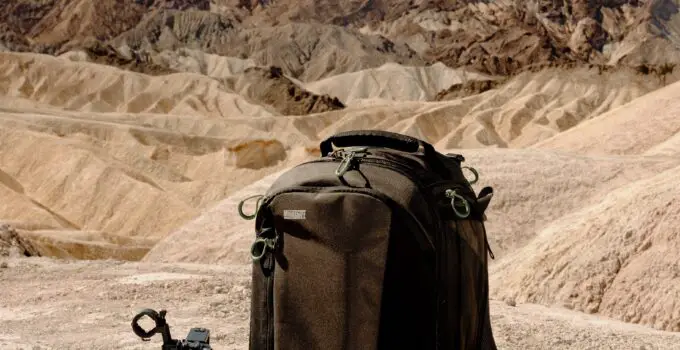Are you unsure about the right size of dry bag to protect your camera? When it comes to safeguarding your camera gear from water damage, choosing the correct size dry bag is essential.
In this article, we will guide you on determining the ideal size dry bag for your camera. Whether you’re a professional photographer or an enthusiastic hobbyist, we understand the value of keeping your gear safe and dry during outdoor adventures.
Join us as we explore the factors to consider and expert recommendations to help you make an informed decision about the perfect size dry bag for your camera.
Thus before moving forward here check out how to please a photo camera in bag?
Importance of Protecting Your Camera
Your camera is a valuable asset that enables you to preserve memories and capture breathtaking moments. Water damage can be catastrophic, leading to costly repairs or even permanent loss of your equipment.

Therefore, it’s crucial to invest in a reliable dry bag that provides the necessary protection for your camera.
Understanding Dry Bags (What size dry bag for camera?)
Dry bags are specially designed waterproof containers made from durable materials such as PVC or nylon.
They feature a roll-top closure or a waterproof zipper to create a watertight seal. Dry bags come in various sizes, each designed to accommodate different gear and equipment.
But what size dry bag for camera in perfect?
What size dry bag for camera in perfect?
The size of the dry bag for a camera will depend on the specific camera model and any additional equipment you plan to store.
As a general guideline, it is recommended to choose a dry bag that is at least 1.5 to 2 times larger than the dimensions of your camera. This allows for extra space to accommodate accessories like lenses, batteries, and memory cards.
Additionally, consider the size of any future upgrades or equipment you may acquire.
It’s better to have a slightly larger dry bag to ensure everything fits comfortably and to provide room for proper sealing and protection against water damage.
Thus here check out what kind of camera bag should you use when having a shoulder pain.
Factors to Consider When Choosing a Dry Bag for Camera?
Camera Size and Accessories
The size of your camera and the accompanying accessories is a primary consideration.
Measure the dimensions of your camera body, including any attached lenses, and ensure that the dry bag you choose provides enough space to accommodate them comfortably.
Additional Items
Apart from your camera, consider any additional items you may need to protect.

These could include spare batteries, memory cards, lens filters, or even a small tripod. Ensure that the dry bag has enough room to fit these items alongside your camera.
Here you can check out what kind of camera bag is needed when having a active in camera.
Future Expansion
If you plan to expand your camera gear collection in the future, it’s wise to choose a dry bag with some extra room. This allows you to accommodate new accessories without the need to purchase a larger bag later on.
Carrying Options
Consider how you plan to carry your dry bag during your outdoor adventures. Some dry bags come with shoulder straps or backpack-style harnesses, while others can be attached to your existing backpack. Choose a carrying option that suits your needs and ensures convenience and comfort.
5. Recommended Dry Bag Sizes for Different Camera Types
Compact Cameras
For compact cameras, which are generally smaller and lightweight, a small-sized dry bag should suffice.
Look for a dry bag with a capacity of around 5 to 10 liters. This size will comfortably accommodate your compact camera, spare batteries, memory cards, and other small accessories.
Mirrorless Cameras
Mirrorless cameras are more compact than DSLRs but often come with interchangeable lenses. To protect your mirrorless camera and a couple of lenses, opt for a medium-sized dry bag with a capacity ranging from 10 to 20 liters.
This size provides ample space for your camera body, lenses, batteries, memory cards, and other essentials.
DSLR Cameras
DSLR cameras are bulkier due to their larger bodies and a wider range of lenses. To safeguard your DSLR camera, multiple lenses, and additional accessories, a larger dry bag is necessary.
Consider a dry bag with a capacity of 20 to 30 liters or more, depending on the size of your gear. This size will accommodate your DSLR body, lenses, batteries, memory cards, filters, and other essentials.
Here you can check how to pack camera gears in dslr?
Tips for Using a Dry Bag (What size dry bag for camera?)
To ensure optimal protection for your camera and gear, here are some useful tips for using a dry bag:
Properly Seal the Bag
Before placing your camera inside the dry bag, make sure to roll the top closure or close the zipper properly to create an airtight and watertight seal. This step is crucial in preventing water from seeping into the bag.

Remove Excess Air
When sealing the bag, try to squeeze out as much excess air as possible. Removing air helps reduce the risk of condensation and improves the overall waterproofing capabilities of the dry bag.
Test the Bag Before Use
Before heading out on your adventure, perform a simple test by placing some tissue paper or a dry cloth inside the dry bag and submerging it in water for a few minutes.
Check for any signs of moisture or leaks. If everything remains dry, you can proceed with confidence.
Avoid Extreme Temperatures
While dry bags are designed to protect your gear from water, they may not provide sufficient insulation against extreme temperatures.

Avoid exposing your dry bag to excessive heat or cold, as this can potentially damage your camera and accessories.
Handle with Care
Even though your camera is safely stored inside a dry bag, it’s essential to handle the bag with care.
Avoid dropping or subjecting the bag to unnecessary impact, as this can cause damage to your camera equipment.
FAQs
Can I use any waterproof bag for my camera?
While there are various waterproof bags available, it’s recommended to use a specifically designed dry bag for optimal protection.
Can I fit multiple cameras in one dry bag?
It depends on the size of the dry bag and the cameras. Larger dry bags may have enough space for multiple cameras, but ensure proper padding and protection between them.
Are dry bags only for water activities?
Dry bags are commonly used for water activities like kayaking, boating, or beach outings. However, they are also useful in protecting your camera from other elements like dust, sand, or rain during various outdoor adventures.
Can I keep other valuables in the dry bag along with my camera?
Absolutely! Dry bags are versatile and can be used to protect other valuables such as smartphones, wallets, documents, or clothing from water damage.
How do I clean and maintain my dry bag?
Cleaning and maintenance are essential to prolong the life of your dry bag. Rinse it with freshwater after each use, remove any debris or sand, and allow it to air dry before storing it. Avoid exposing it to direct sunlight for extended periods as it may degrade the material.
Can I use a dry bag for underwater photography?
Dry bags are not designed for underwater photography. They provide protection against water splashes and brief submersions, but they are not intended for extended periods underwater.
Conclusion
Investing in the right size dry bag for your camera is crucial for safeguarding your gear during outdoor adventures.
By considering the size of your camera and accessories, along with factors like future expansion and carrying options, you can choose the ideal dry bag to meet your needs.
Remember to follow the tips for using a dry bag effectively to ensure maximum protection for your camera equipment.







